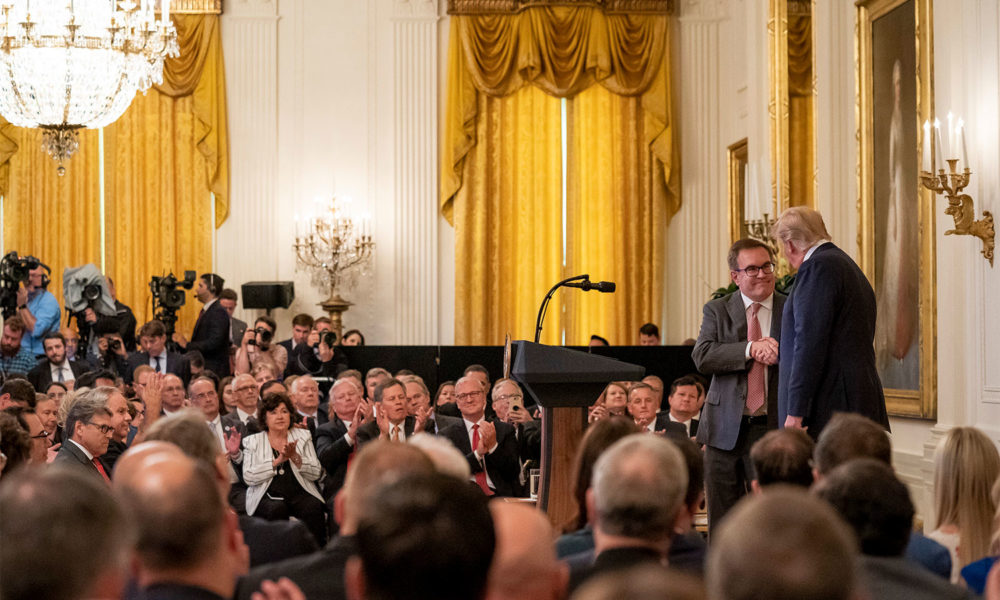This June, the Trump administration’s Environmental Protection Agency (EPA) proposed a new rulemaking, Increasing Consistency and Transparency in Considering Benefits and Costs in the Clean Air Act Rulemaking Process.
The proposal is, by every measure, an object lesson in this administration’s shambolic governing approach: bad-faith actions, dressed up with claims of high-minded ideals, felled by staggering ineptitude.
Under the guise of boosting “consistency” and “transparency,” the administration is in fact attempting to severely curtail the EPA’s ability to issue, uphold, and strengthen clean air standards by distorting and devaluing how the benefits of pollution protections are calculated. The proposal is without merit, be it legal, scientific, or economic.
For this malfeasance, obfuscation, and incompetence to be rejected and reversed, it has to be called out.
So speak up. Join us in the fight to defend the Clean Air Act from this deeply consequential attack.
The proposal is open for public comment now through the close of Monday, August 3; the Union of Concerned Scientists has made it easy to submit a comment here.
Below, some added context and key points of concern.
Cost-benefit context
The concept of cost-benefit analysis is straightforward: policies have effects, positive and negative, and understanding those potential costs and benefits can help inform the deliberative process around a given action.
In the face of incredible decision-making complexity, the prospect of such a simple, clear-cut tabulation is near irresistible.
The catch is, cost-benefit analysis is only as robust as the data that inform it and the methods used to conduct it. And as this proposed rulemaking attempts to take advantage of: those inputs and those mechanisms can be readily skewed.
This wouldn’t be the first time.
For decades, when it came to evaluating environmental regulations, cost-benefit analysis was industry’s favored tool. That’s because for a long time, the overwhelming majority of what could actually be quantified and put into the ledger was anticipated costs to industry, not anticipated benefits to public health.
In recent years, however, cost-benefit analysis has increasingly come under polluter attack.
Why?
Steadily accumulating evidence of the many and varied harms of air pollution on human health and the environment. Evidence that can be translated into quantifiable benefits—benefits demonstrating enormous support for strong pollution standards.
Which brings us to today, and this new attempt to rig the game.
A brazen attack on public health
EPA’s new cost-benefit proposal is, in a word, brazen.
And really, it has to be, if the administration’s end goal is to overcome the towering benefits of pollution protections to justify weaker standards instead.
To get a sense for just how brazen, though, consider this: when the EPA previewed just one aspect of the new proposed approach in its recent attack on the Mercury and Air Toxics Standards (MATS), a limit on mercury pollution from coal plants, the agency asserted that it now believed it inappropriate to consider public health benefits estimated at $37 billion to $90 billion annually. Or in terms of the human toll, to disregard the potential annual avoidance of 11,000 premature deaths, 4,700 heart attacks, 130,000 asthma attacks, and 540,000 lost workdays.
Which means that if one were to have the chance to define the proposal in two words instead of one, that would make it brazen, and shameless.
The recent attack on MATS showcases the primary approach of this proposal’s benefit accounting take-down: exclude from consideration all co-benefits, or the benefits that occur because of a pollution intervention but were not the target of the intervention. This defies logic, let alone best practice. Pollution controls commonly result in the reduction of many pollutants at once, even if it was a single pollutant that initially motivated their use. Broad-based benefits should obviously be incorporated and considered, as is common—and again, best—practice. The only reason to exclude co-benefits is to artificially lower the calculated benefits of pollution protections.
Importantly, while its attack on co-benefits is the headliner, this proposal also advances another attack on quantifying benefits, more discreet but no less nefarious. Specifically, the EPA is proposing requirements that would skew lower the health effects fed into these analyses, again defying best practice and expert guidance to force the incorporation and disproportionate weighting of studies finding no harmful effects.
To understand the full extent of the malfeasance here, it’s essential to be aware of existing EPA practice. First, courtesy regulatory specifics and accompanying case law, whether and how the EPA should consider costs and benefits in a given rulemaking are already well understood. Second, for times when questions do arise around best practice, EPA already has guidelines for conducting analyses—including cost-benefit analyses—that are detailed, peer-reviewed, and periodically updated to reflect advances in the field. Furthermore, the Office of Management and Budget (OMB) also has cost-benefit guidelines, referred to as Circular A-4, that have long governed best practices for such analyses across the whole of the government.
Notably, in this proposed rulemaking, EPA repeatedly muddies the waters but then attempts to cover itself by pointing back to the above-noted statutory specifics, Guidelines, and Circular A-4 for more details on proper approach and best practices—except, that is, for when the agency proposes to: 1) ignore co-benefits, and 2) change how health endpoints are quantified. Then, this administration is off on its own, apart from best practice of every kind.
Transparently biased, consistently corrupt
It bears repeating: the mission of the EPA is to protect human health and the environment.
To advance that mission, we need continued progress on air pollution. Because despite enormous progress to date, air pollution still harms the health and well-being of far too many, with disparities in burden tied to race and poverty status, with the heaviest pollution burden borne by Black communities.
This proposal, though, does not advance EPA’s mission, nor reckon with the hard pollution challenges that remain.
Instead, as the Trump administration has done again, and again, and again, this proposal attempts to advance the interests of a select polluting few over the health and well-being of all the rest. With long-lasting ramifications, to devastating ends.
Submit a comment and oppose this clean air attack
So join us, and fight back. Submit a comment before the deadline of Monday, August 3. When you do, keep in mind the key points noted above:
- There is no justification for this rule. EPA already has long-standing guidance and peer-reviewed guidelines. Instead, this rule would undermine the agency’s ability to issue rules based on the best available science and curtail the advancement of strong pollution standards.
- EPA must include the consideration of all benefits when evaluating rules, including co-benefits. It is inappropriate and counter to logic and best practice to exclude entire tranches of public health benefits when considering the true benefits of regulatory interventions.
- This proposed rule threatens to dangerously and harmfully exacerbate the already inequitable distributional impacts of air pollution. EPA must consider the environmental justice implications of its actions.
- EPA must appropriately value the impacts of all pollutants, not work to distort and devalue them to artificially skew cost-benefit analysis findings. The proposed rule is particularly alarming in its arbitrary and unscientific strictures around the quantification of health endpoints, as well as its nonsensical minimization of the social cost of carbon.
EPA must put the interests of public health and the environment over protecting the profits of a malfeasant polluting few. Reject this bad-faith clean-air attack: submit your comment today!

